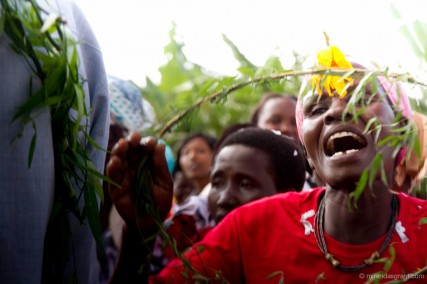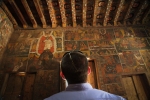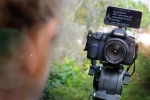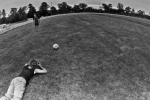The art of laughter and giving
Australian comedian Judith Lucy expands her repertoire to the vaginas of African women but says she’s way cooler than Bono.
[raw]Vimeography Error: a Vimeography gallery with an ID of "27" was not found.[/raw] [wptab name=’Page 1′]Behind a drop-toilet block in the crisp highlands of the Kween district in eastern Uganda, almost thirty women are assembled. Three of them are white: Judith Lucy, an ActionAid staffer and me, the photographer.
Through rolling fields of maize in various stages of cultivation, some women have walked six hours to be here. They are wrapped in kitenge, the vibrant African batik, and clad in t-shirts branded with logos of various NGOs. Most are sporting faded red ActionAid tees.
ActionAid is after all the reason for today’s pilgrimage.
Judith is offered a white plastic chair but instead flaps her pashmina onto the goat-mown grass and curls her feet under her bum to sit eye to eye with the women.
“I have read about FGM but it’s very different hearing your stories and how it has affected your lives,” Judith begins. “I realize that it’s a very personal subject and it’s difficult to talk about. I am very grateful if you feel you can share anything with me.”
She pauses for the translation and then adds a note of encouragement:
“Because when women come together we share and that empowers all of us.”
I only know Judith Lucy from the TV. Red lipstick caught in a half-smile, she appears shrewd, self-deprecating and laconically melodramatic. But here, in hiking boots and linen pants bequeathed to her by the ABC wardrobe department for a production trip to India, she’s somewhat softer. Her grey-blue eyes are steadfast and glassy and she is constantly nodding as if imagining herself in the shoes of these women – or lack thereof.
[/wptab] [wptab name=’2′]Janet Shero introduces herself and opens the conversation. She explains that her father decided to have her circumcised at the same time as her older brothers.
“My father forced me. I was very young. I had no option.”
Janet was in her final year of primary school when she underwent the ceremonial circumcision.
“The day before I was to be circumcised, people came from far and wide to the village and held a traditional dance throughout the night.”
Preparing her for the cutting, elders smeared traditional white soil across her eyes so she could neither see nor sleep.
“After the night of dancing, very early in the morning at about 5am, they took me to the river. It’s a private place in the Sabiny culture. At the river, it was very cold. In that private place, they didn’t tell me what they were using to cut me. There are some leaves they swept on my private parts so that when they are cutting you don’t feel pain. But my private parts just swelled.”
Certain cultures amputate different parts of the vagina, from cutting part or the whole clitoris to removal of the entire labia. Janet underwent the full circumcision.
“I bled so much. And yet there are no drugs that you can be given. They just gave me some milk and some traditional local brew, which is mixed with so many traditional things I don’t even know. When they cut you, one leg remains paralyzed for up to a day. Also, another problem is that when you’re cut, everything remains open.”
Like all Sabiny women who are circumcised, Janet was branded on the forearm with a grid of razor cuttings. These cuts are smeared with a local weed that inflames the wound, causing the woman to itch and deepen the scar.
Janet was 14 when her vagina was dismembered. She is now 43.
“Now when I meet with my husband, he does not take a lot of time. My husband just enters me anyhow because there is nothing really that can prevent it. You cannot even romance for long. Another thing, when the clitoris is removed, there is nothing that can produce these fluids. Sex is painful. I don’t even want to share a bed with him.”
During the ceremonial dancing, Janet was warned that if she ever spoke about the pain of circumcision publicly, she would be cursed, she would go mad and her children would die.
[/wptab] [wptab name=’3′]Worldwide, almost three million girls are circumcised each year. According to ActionAid, Egypt and Ethiopia are responsible for half these cases while 26 documented countries across Africa, Asia and the Middle East account for the remainder. In Uganda, female genital mutilation is a cultural practice of the Sabiny tribe in the east. Circumcision of the clitoris and labia minora is considered a rite of passage, prepares young women for marriage and permits them to collect dung, walk through maize fields and milk cows – tasks an uncircumcised woman cannot do.
The ritual, though made illegal in 2010 by the Ugandan government, is mostly performed and perpetuated by female elders. These ‘surgeons’ defend the practice in two ways: as an important tradition of their tribe and as their means to earn a living.
One third of girls who undergo the surgery die of infection or blood loss as the rituals are often performed with blunt knives, razor blades and broken glass. Because the practice is outlawed, young women are taken at night to remote bush land areas and sometimes across the Kenyan border to undergo their circumcision.
“I tried so much to avoid going through circumcision,” Yeisha Rose, now 47, explains.
“I got married and even produced one baby before I was circumcised. It was after this first birth that my mother and father visited my husband’s village and insisted I undergo female circumcision.”
Her parents were concerned their grandchild would suffer social exclusion and that Rose would be decried for witchcraft.
“When I was circumcised, I really bled a lot to the point of being unconscious. I was cut in the morning but I didn’t return to my senses until 2pm in the afternoon. I went back to my marriage and conceived another child. My private parts were now like a scar and when it came time to give birth, it was very difficult for me to push the baby through.”
On a plastic chair propped between two wooden poles, Rose was carried 18km to the nearest medical clinic. Upon arrival, there was no option but to cut open her scar to make way for the child.
“After that cutting, it was very difficult for the medical people to stitch the scar so my private parts remained uncovered. After birth, whenever I urinated, I could just feel it coming down my leg.”
Rose gave birth to seven more children. Seven times her scar has been recut.
As the conversation draws to a close, Judith invites the women to ask her anything they’d like. They ask her how she feels about FGM.
“Its really distressing to hear that you’ve been through all this,” she says.
“It’s like when you see a man get kicked very hard in the testicles and you see the other men go [eeh!]. I hear these stories and it just makes me feel like that to a huge degree.”
Gaining confidence, one woman asks Judith if she has children and a husband. When Judith informs them she is 45 years old and has chosen not to have children, they begin to giggle. When she tells them she does not have a husband but does have a boyfriend, the women cling to each other laughing wildly.
It’s evident now why ActionAid has solicited Judith. She’s very vocal about her own brand of feminism, which has won her the affection of women – and men – Australia-wide. The ABC and Screen Victoria have just pledged funding for a 6-episode series she will create about gender and identity in 2014. However, it is in this uproar of laughter that I get it. Judith is just so personable.
[/wptab] [wptab name=’4′]When the cackles subside, an older woman missing shoes and two front teeth shifts attention from the grass basket she is weaving to address Judith. She doesn’t clear her throat. She doesn’t need to. She’s wanted to ask her question since our delegation arrived.
“If we agree to stop FGM, what else do you think we can replace our culture with?”
76 year-old Grace Chebatt’s exasperation is underwritten by suspicion. Exploitation is a recurring theme throughout Uganda’s history and there is a valid pushback against any hint of neo-colonial intervention. Uganda’s president Museveni, though revered by many for stabilizing his country after decades of bloody despotism, has been criticized for his reliance on foreign aid and leniency towards the Western conditionality of this aid. In turn, INGOs like ActionAid are accused of cultural imperialism but accepted as an unavoidable concession for economic constancy.
But surely female genital mutilation contravenes universal human rights and ActionAid is obligated by cosmopolitan ethics to educate the uneducated and eradicate harmful cultural practices in order to protect the vulnerable. Right?
Communities across Uganda have been brought up on charitable handouts: blankets, goats and the iconic half a cup of rice a day. Such dependency underpins a brand of international aid widespread during and after decolonization. In the 90’s, the methodology of INGOs shifted away from service delivery towards a livelihoods approach: teach a man to fish and he’ll eat for a lifetime etc etc. ‘Capacity building’ and ‘economic empowerment’ are catch-cries of this style of development.
But what if that man (or woman) knows how to fish but doesn’t have access to a clean, safe pond in which to fish? ActionAid addresses this dilemma through a rights-based approach. ‘Reflect’ circles connect women and promote solidarity. Education and sensitization spearhead cultural transformation. Increased access to information empowers grassroots communities to fight for their rights, hold their government to account for the delivery of essential services and the prevention of human rights abuses.
So where does this place Judith?
[/wptab] [wptab name=’5′]During her week in Uganda, Judith travels to the Kapchorwa, Katakwi and Kween districts in the remote eastern region of Uganda. The aim is to learn more about FGM, the livelihoods of women and the work of ActionAid on the ground. Driving slowly along dirt tracks, we observe thatched-roof mud huts, manual water pumps and small-scale gardens. Upon arrival, crowds of men, women and children dance and sing inconsolably. Judith is decorated with a woven grass wreath laden across her shoulder and invited to join the dance. Each hand clutched by a buoyant woman, her arms flail as she stomps her boots up and down to the beat of a hollowed-gourd drum. An elderly woman, whose glaucomic eyes are framed by deep, weathered creases, shrieks from the back of her throat and flaps her palm against her open mouth to create a piercing tone of celebration. Is this how vibrant a circumcision ritual is?
After the performance, Judith is seated on a chair in front of the congregation who slouch languidly in the dust. Formal testimonials are delivered describing the influence of ActionAid in the village; the increased political awareness and emerging sense of empowerment especially for women. Judith is introduced as The Ambassador and asked to speak. She laughs warmly at the extravagant status bestowed on her and proceeds to explain the reason for her visit. When the crowd’s applause subsides, the air is left with the weight of hope that Judith’s celebrity will bear fruit in this dusty corner of Africa.
“The challenge is to take a situation that in many ways is very depressing and disheartening and try and talk about it in a way that people are engaged by it. I just think there is a kind of exhaustion. People have seen so many ads with malnourished African children and ‘for just half a cup of rice’ and, you know, that’s all just a bit too hard.”
To unwind at dusk, Judith and I promenade through the township of Kapchorwa, the service center of this far-away region in this far-away continent. We walk at a brisk pace and nod at the transfixed children as we pass by. I ask her how adequate she feels to address the Australian people on behalf of the Sabiny women of Uganda.
“All I can do is write and talk,” she answers in her familiar self-deprecating way. “So if that can help, then that’s what I can do.”
Tasked to help Australian’s care about the clitorises of African women and raise funds accordingly, Judith’s job seems like a tough gig. But with twenty-five years of stand-up comedy under her belt, she knows how to play the crowd.
[/wptab] [end_wptabset]To explore a gallery of photographs taken on this journey, head here.





